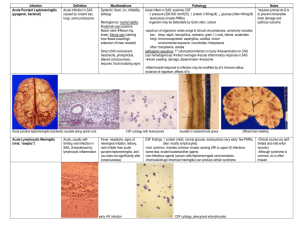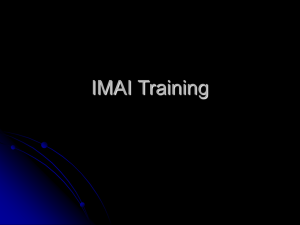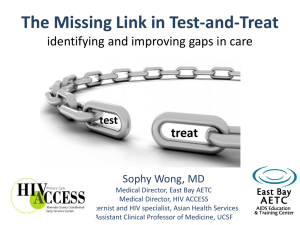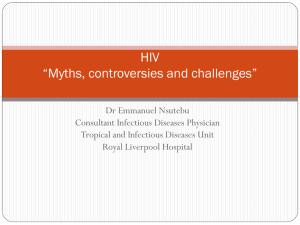Acute HIV Infection
advertisement
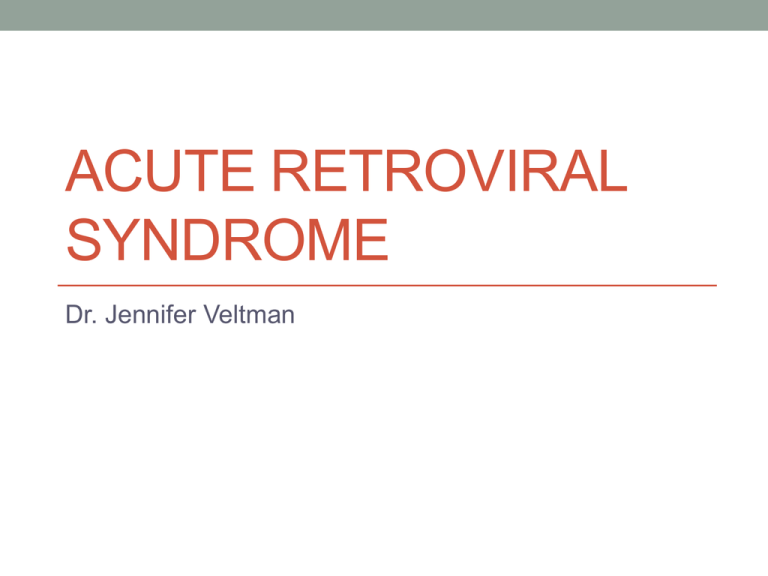
ACUTE RETROVIRAL SYNDROME Dr. Jennifer Veltman Acute Retroviral Syndrome (ARS) • Definitions • Epidemiology • Clinical course • Symptoms • Diagnosis • Treatment What is Acute Retroviral Syndrome??? Definitions: Acute HIV Infection: Phase of HIV disease immediately after infection during which the initial burst of viremia in newly infected patients occurs: antiHIV antibodies are undetectable at this time, while HIV RNA or p24 antigen are present. Recent Infection: considered the phase up to 6 months after infected during which anti-HIV antibodies are detectable. Early HIV: either acute or recent HIV infection Acute retroviral syndrome: patient w/ acute HIV infection w/ symptoms. Epidemiology • 40-90% of people infected with HIV develop ARS • Reported more in those infected via sexual exposure or health care related (needle stick) compared to IVDU • Onset 1-6 weeks after exposure. Peak onset is 3 weeks after exposure. • Day 0 • exposed to HIV, and infection begins. • Day 8 • virus is detectable in blood using (PCR) • antibody test are negative. • amount of virus in the blood more than doubles every day. • The CD4 cell count (and total white blood cell count) begins to drop • Weeks 2-9 • viral load peaks and begins to decline as the immune system begins to battle the virus • highly infectious!!! • Weeks 10-24 • HIV viral load drops to its lowest point, also known as the set point, which is different in each person. • antibody tests become positive for HIV. Seroconversion is now complete, and chronic HIV infection begins. Window period What are the symptoms of Acute Retroviral Syndrome? Symptoms Symptom # w/ finding (n=209) Frequency % Fever 200 96 Enlarged lymph nodes 154 74 Sore throat 146 70 Rash 146 70 Sore muscles or joints 112 54 Low platelets 94 45 Low WBC 80 38 Diarrhea 67 32 Headache 66 32 Nausea/vomiting 56 27 Elevated liver enzymes 38 21 Enlarged liver/spleen 30 14 Thrush 24 12 Neuropathy 13 6 Encephalopathy 12 6 What are some other diseases that can cause similar signs/symptoms? • “MONO” (EBV or CMV infection) • Sore throat, fatigue, enlarged glands, fever, muscle or joint aches, rash, enlarged liver/spleen, elevated liver enzymes, low platelets • Influenza • Muscle aches, fevers, nausea, vomiting, diarrhea, fatigue • Acute HSV (Primary Herpes Infection) • Fever, fatigue, sore throat, headache, rash, sore muscles, enlarged glands near ulcer • Secondary Syphilis • Fatigue, headache, poor appetite, nausea, joint aches, fever, (rarely) meningitis and liver inflammation • Acute Hepatitis • Fever, fatigue, elevated liver enzymes, enlarged liver Symptoms • Symptoms resolve 10-15 days • Acute opportunistic infections have been reported • Examples: P. jirovecii pneumonia, Cryptococci meningitis, and Candida esophagitis. • Likely caused by the depression of the CD4+cell count generally seen in acute HIV infection. Diagnosis: • high-level HIV RNA viral load in the absence of anti-HIV antibodies. • (+)viral load. (–)ELISA • ELISA remains negative for an average of 2 to 6 weeks after the onset of symptoms, despite the appearance of specific antibodies on a Western blot of the patient’s serum. • If VL <10,000, may be false positive b/c usually VL >100,000 copies/mL • Pt should have elisa repeated over next 3-6 months to document seroconversion Should your patient get on treatment? Pros of starting treatment during Acute Retroviral Syndrome • Pros: • Symptom relief • Decreases viral reservoir and viral set point • Decrease rate of viral mutation by suppressing viral replication • Prevent immune destruction • Public health, reduces transmission to serodiscordant sexual partners Cons of starting treatment during Acute Retroviral Syndrome • Cons: • Toxicity of medications • Risk of developing drug resistance if adherence is poor • Quality of life w/ daily medication in which strict adherence is necessary • Cost The Setpoint Study (ACTG A5217): Effect of Immediate Versus Deferred Antiretroviral Therapy on Virologic Set Point in Recently HIV-1–Infected Individuals In 1 year, about half of patients needed to start ART in Delayed Treatment group Time to meeting eligibility criteria for initiation or reinitiation of antiretroviral therapy (ART) for the immediate treatment (IT) and deferred treatment (DT) groups over the 96 weeks of the study; times were significantly longer in the IT group (P < .001; log–rank test). Hogan C M et al. J Infect Dis. 2011;infdis.jir699 Guidelines say… • Treatment optional , unless pregnant, then recommended What to say to patients… from www.aids.gov/hiv-aids-basics • Within 2-4 weeks after HIV infection, many, but not all, people develop flu-like symptoms, often described as “the worst flu ever.” Symptoms can include fever, swollen glands, sore throat, rash, muscle and joint aches and pains, fatigue, and headache. This is called “acute retroviral syndrome” (ARS) or “primary HIV infection,” and it’s the body’s natural response to the HIV infection. • During this early period of infection, large amounts of virus are being produced in your body. The virus uses CD4 cells to replicate and destroys them in the process. Because of this, your CD4 count can fall rapidly. Eventually your immune response will begin to bring the level of virus in your body back down to a level called a viral set point, which is a relatively stable level of virus in your body. At this point, your CD4 count begins to increase, but it may not return to pre-infection levels. It may be particularly beneficial to your health to begin ART during this stage. • It is important to be aware that you are at particularly high risk of transmitting HIV to your sexual or drug using partners during this stage because the levels of HIV in your blood stream are very high. For this reason, it is very important to take steps to reduce your risk of transmission. References • DHHS guidelines for the use of antiretroviral agents in HIV-1 infected adults and adolescents; considerations for antiretroviral use in special patient populations. Acute and recent HIV infection. Last updated 2/12/13. http://aidsinfo.nih.gov/guidelines/html/1/adult-andadolescent-arv-guidelines/20/acute-and-recent--early--hiv-infection • Mendel's • http://www.thebody.com/content/art16805.html • Emedicine accessed 8/10/13 Now, how much do you remember? • Definitions • Epidemiology • Clinical course of ARS • Symptoms • Diagnosis • Treatment What are the most common signs/ symptoms in Acute Retroviral Syndrome? Symptoms Symptom # w/ finding (n=209) Frequency % Fever 200 96 Enlarged lymph nodes 154 74 Sore throat 146 70 Rash 146 70 Sore muscles or joints 112 54 Low platelets 94 45 Low WBC 80 38 Diarrhea 67 32 Headache 66 32 Nausea/vomiting 56 27 Elevated liver enzymes 38 21 Enlarged liver/spleen 30 14 Thrush 24 12 Neuropathy 13 6 Encephalopathy 12 6 What are the Pros of treating patients during Acute Antiretroviral Syndrome? Pros of starting treatment during Acute Retroviral Syndrome • Pros: • Symptom relief • Decreases viral reservoir and viral set point • Decrease rate of viral mutation by suppressing viral replication • Prevent immune destruction • Public health, reduces transmission to serodiscordant sexual partners What are the Cons of treating patients during Acute Antiretroviral Syndrome? Cons of starting treatment during Acute Retroviral Syndrome • Cons: • Toxicity of medications • Risk of developing drug resistance if adherence is poor • Quality of life w/ daily medication in which strict adherence is necessary • Cost How do you diagnosis Acute Retroviral Syndrome? Diagnosis: • high-level HIV RNA viral load in the absence of anti-HIV antibodies. • (+)viral load. (–)ELISA • ELISA remains negative for an average of 2 to 6 weeks after the onset of symptoms, despite the appearance of specific antibodies on a Western blot of the patient’s serum. • If VL <10,000, may be false positive b/c usually VL >100,000 copies/mL • Pt should have elisa repeated over next 3-6 months to document seroconversion When are HIV patients the most infectious? • Day 0 • exposed to HIV, and infection begins. • Day 8 • virus is detectable in blood using (PCR) • antibody test are negative. • amount of virus in the blood more than doubles every day. • The CD4 cell count (and total white blood cell count) begins to drop • Weeks 2-9 • viral load peaks and begins to decline as the immune system begins to battle the virus • highly infectious!!! • Weeks 10-24 • HIV viral load drops to its lowest point, also known as the set point, which is different in each person. • antibody tests become positive for HIV. Seroconversion is now complete, and chronic HIV infection begins. What is the window period? Window period Thank you!
